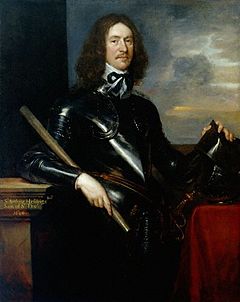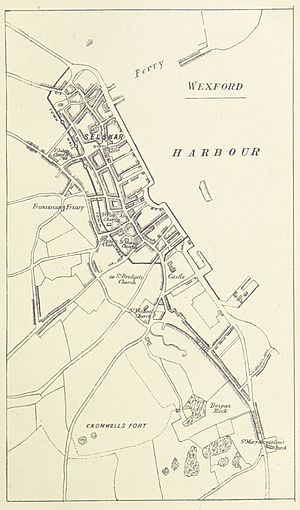Thomas Horton (soldier) facts for kids
Quick facts for kids
Thomas Horton
|
|
|---|---|

Trial of Charles I, January 1649; Horton was one of the judges
|
|
| Born | January 1603 Gumley, Leicestershire, England |
| Died | 15 October 1649 (aged 45–46) Wexford, Ireland |
| Allegiance | |
| Years of service | 1642–1649 |
| Rank | Colonel |
| Unit | Colonel Thomas Horton's Regiment of Horse |
| Commands held | Commissioner for South Wales 1649 |
| Battles/wars | |
Colonel Thomas Horton (born January 1603, died October 1649) was an English military leader. He came from a family of minor landowners in Leicestershire. Horton served in the Parliamentarian army during the Wars of the Three Kingdoms, a series of conflicts in Britain and Ireland.
He was one of the judges who approved the execution of King Charles I in January 1649. Horton was also a religious Independent, a group that believed in self-governing churches. He later became a Baptist. His family had strong ties to Sir Arthur Haselrig, a key figure whose attempted arrest by King Charles I helped start the First English Civil War in 1642.
During the Second English Civil War in 1648, Horton played a big part in stopping a rebellion in South Wales. For this, he received land in Pembrokeshire. In August 1649, his army unit was sent to Ireland. He sadly died from a disease in Wexford in October 1649, and his burial place is not known.
Contents
Who Was Thomas Horton?

Thomas Horton was born in Gumley, Leicestershire. He was the second son of William Horton (1576-1638) and Isabell Freeman (who lived past 1649). In 1608, his father bought land in Gumley, which meant their family was part of the "minor gentry." This term described families who owned land but were not nobles.
Thomas was one of eight children who survived. These included his older brother John, and younger brothers James, Andrew, Robert, and William. He also had two sisters, Elizabeth and Mary. Most of his siblings were still alive in 1649.
In 1645, Thomas married the daughter of John and Margaret St Loe. She likely died soon after, as she is not mentioned in his will. His will named her parents as guardians for his son, also named Thomas. Some believe this son later moved to America, settling in Milton, Massachusetts, and dying in Rehoboth, Massachusetts in 1710.
Horton's Early Career
We don't know much about Horton's life before 1642. However, we do know he was connected to a powerful local leader, Sir Arthur Haselrig. Some people thought Horton worked for Haselrig as a falconer, someone who trains birds for hunting. But records show he was actually a small landowner himself.
Sir Arthur Haselrig was a Puritan, like Oliver Cromwell and John Pym. Puritans were a group of Protestants who wanted to "purify" the Church of England. Haselrig was involved with the Saybrook Colony, a settlement in what is now Connecticut in America. Thomas Horton helped his youngest brother, William, with money to move there in 1635.
Fighting in the First English Civil War
In January 1642, King Charles I tried to arrest five members of Parliament, including Haselrig. This event was a major cause of the First English Civil War, which began in August 1642. Haselrig quickly formed his own army unit. This unit was nicknamed the 'London Lobsters' because of their special armor.
Horton joined this unit as a cornet, a junior officer who carried the flag. He fought in his first major battle at Edgehill in October 1642. In 1643, he was promoted to captain-lieutenant. He served in William Waller's army through 1643 and 1644. During this time, he fought in important battles like Lansdowne, Roundway Down, Cheriton, and the Second Newbury.
In 1645, the New Model Army was created. This was a new, professional army for Parliament. Haselrig's unit became Colonel John Butler's Regiment of Horse, and Horton became Butler's second-in-command. Horton was badly hurt at the Battle of Naseby in June 1645. But he recovered and returned to fight in the Western Campaign of 1645-1646. This included battles at Langport and Torrington. The war ended in June 1646 when the Royalist stronghold of Oxford surrendered.
Second English Civil War

After the first war, there were disagreements about how to make peace with King Charles. Parliament was split between moderates, who were mostly Presbyterians, and radicals, who were often religious Independents. This group included Baptists, who were very strong in the New Model Army. Both Horton and his close friend, Colonel John Phillips, were part of a Baptist church in Cardiff in 1649.
The war had been very expensive. A bad harvest in 1646 and a return of the plague made things worse. Parliament struggled to pay its soldiers. The New Model Army supported the radicals because they wanted their unpaid wages. By March 1647, the army was owed a huge amount of money. Horton signed his regiment's 'Petition of Grievances' in May. When Colonel Butler resigned in June, Horton took over as Colonel.
The relationship between Parliament and the Army Council got worse. This led to the army taking control of London. Another area of concern was Wales. This region was held by the Western Association army, led by John Poyer and Rowland Laugharne. They supported the moderate Parliamentarians. By early 1647, people worried if they could be trusted.
From 1642 to 1646, most of Wales had supported the King. Harlech Castle only surrendered in March 1647. Worries grew when secret messages were found between King Charles and the Irish Confederacy. People feared that places like Cardiff and Milford Haven could be used to bring Irish troops to England. So, in July 1647, Horton and a small group from the New Model Army were sent to South Wales to watch the situation.
By March 1648, Poyer's soldiers in Wales had not been paid for 18 months. Poyer refused to give up Pembroke Castle until they were paid. Horton reported to London that local people were also angry about paying taxes for an army they didn't want. What started as a pay dispute turned into a rebellion in April. Poyer, Laugharne, and Rice Powell declared they supported bringing back King Charles. This started the Second English Civil War. They gathered an army of about 8,000 men. They hoped to defeat Horton's smaller force of 3,000 before Cromwell could send help. However, Horton's soldiers were experienced, while most of the Royalist troops were untrained. Horton won an easy victory at St Fagans on May 8.
Soon after this victory, Cromwell arrived in Wales with another 6,500 men. He began to besiege Pembroke Castle. After capturing Tenby, Horton joined Cromwell there at the end of May. The siege was delayed for a month while they waited for large cannons to arrive. Once the cannons were there, Poyer surrendered on July 11.
War in Ireland
In 1645, Laugharne had been given land that was taken from a Welsh Royalist. This land was now given to Horton and Phillips, along with others. Horton and Phillips were also put in charge of collecting a large fine of £20,000 from Welsh Royalists. In January 1649, Horton was chosen to be a judge on the High Court of Justice for the trial of King Charles I. He signed the official order for the King's execution.
Soon after, he was made Commissioner for South Wales. But in July, his army unit was chosen to fight in Ireland. He arrived in Dublin in September. He took part in the siege of Wexford, which lasted from October 2 to October 11. In a letter dated October 25, Cromwell wrote that Horton "is lately dead of the country-disease." This usually meant dysentery, a common illness caused by poor hygiene. His grave has since been lost.
In 1654, Parliament approved a payment of £1,454 in back pay to Horton's family. However, when the monarchy was restored in 1660 (the English Restoration), Horton's heirs lost any land they might have inherited because he was one of the judges who condemned the King. It seems his son had already moved to America by then.
Sources
Note: There is not much information available about Thomas Horton. This article uses details from his and his father's wills.

